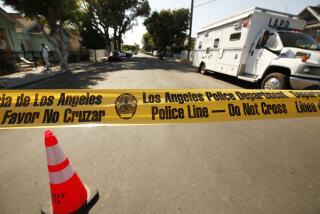Internet Cited for Surge in Bomb Reports
Los Angeles explosives experts have seen an alarming rise in bomb calls over the last several months, and they think they know the main culprits: youngsters on the Internet who are learning to make bombs by scanning computer sites with ominous names like “the Anarchists Cookbook” and “Bombs and Stuff!”
Reports of possible explosives to the Los Angeles Sheriff’s Department have more than doubled in the last two months. More troubling, the percentage of suspicious devices that turn out to be real explosives--especially homemade pipe bombs--has grown even more drastically.
The Los Angeles Police Department has noted a similar rise in bomb reports, reflecting a nationwide trend that experts blame on newfound computer access to explosives recipes.
“A lot of the [cases], we’re finding out, are kids getting the information off the Internet,” said Lt. Tom Spencer, who heads the sheriff’s arson/explosives detail. “We’re very worried, to be honest. . . . It’s frightening.”
Sheriff’s officials believe that information from the Internet was used in a rash of pipe bombings in Rancho Palos Verdes in May and June that destroyed four mailboxes, a guard shack and a car. Four teenagers were arrested last week in the explosions.
In Orange County, meanwhile, police said the Internet may have aided vandals in building acid-filled bottle bombs in Mission Viejo and Huntington Beach. A 5-year-old boy was burned by one of the bombs on a school playground in an April attack that led to the arrests of four teenagers.
And nationwide, computer-generated guides proved a common link in bombs built recently by teenagers around the country, from the streets of Philadelphia and Houston to rural enclaves of Kansas and Upstate New York.
Some bookstores and libraries have long provided printed information on homemade bombs--one such manual was found this week in Torrance after a 23-year-old man allegedly blew out three windows at his parents’ home with a 10-inch-long pipe bomb. But the Computer Age has cast the explosives’ net far wider, experts say.
LAPD spokesman Cmdr. Tim McBride said: “There is a lot of verbiage on the Internet, where people are becoming . . . more aware of what it takes to put a bomb together.”
Indeed, a quick scan of computer sites reveals wide access to sites offering enlightenment on a wide range of bombs, some cast in a serious, academic tone, others in an aggressive or even hostile bent. “Don’t be a wimp. Do it NOW!!!” urges a file on “making and owning an H-bomb.”
One popular site, the Anarchists Cookbook, lists no fewer than 19 chapters related to explosives, from “Making Plastic Explosives From Bleach” to a “Home-Brew Blast Cannon” and “A Different Kind of Molitov [sic] Cocktail.”
USC terrorism expert Richard Hrair Dekmejian believes that users of such technology are often troubled youths who, without intervention, could become involved in more serious violence along the lines of the Oklahoma City, World Trade Center or Unabomber attacks.
The Internet’s bomb-making intrigue offers an outlet for troubled youths who are “bored and alienated,” he said in an interview. “This is very, very serious. This is a new epidemic, and I see the problem getting worse,” Dekmejian said.
The numbers in Los Angeles seem to prove him right.
Both the LAPD and the Sheriff’s Department--the main agencies that handle bombings in the area--have seen marked increases in the last several years in reports of suspicious devices. Last year, responses at each department shot up more than 35% over 1994, reaching 972 calls to the LAPD and 595 to the Sheriff’s Department. Each report of a suspected bomb automatically triggers a response by a bomb squad.
The rise has been even more drastic at the Sheriff’s Department in the last two months. The bomb detail, which had been averaging about 30 calls a month, handled 68 assignments in April and 62 in May.
LAPD officials attribute the rise in part to the public’s increased awareness and sensitivity to the threat posed by bombs, especially after terrorist bombings in Beirut, New York City and Oklahoma City, among other attacks.
For that reason, an abandoned briefcase may be more likely to generate a call to police today than it was a few years ago. But the trend goes beyond public alertness, officials say, and the number of actual explosives discovered has gone up significantly as well.
The LAPD found 41 explosives in 1995, more than double the number three years earlier. And the sheriff’s discovery of explosives rose about 10% over that same period, to 69 bombs. The rise was particularly sharp in 1995 at the Sheriff’s Department, with the number of bombs 50% higher than in the previous year.
The Sheriff’s Department and its 26 bomb technicians recently began using a new 4 1/2-inch-high robot to ferret out possible explosives. Much smaller than its predecessors, it can be used to roam under trucks or through theater aisles to inspect suspicious items.
But technology can be a double-edged sword, and Spencer says his people remain hamstrung as long as the Internet provides free recipes for disaster.
“We can’t do anything because there’s a freedom of speech mandate that says people can put on the Internet what they want, and people will access it if they want to access it,” he said. “The way to stop it is for parents to monitor what their kids are doing.”
More to Read
Sign up for Essential California
The most important California stories and recommendations in your inbox every morning.
You may occasionally receive promotional content from the Los Angeles Times.











